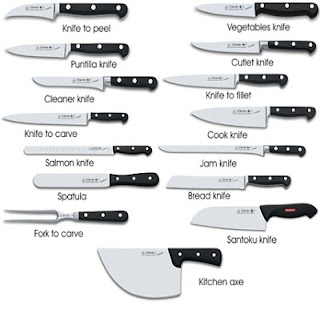Shopping for kitchen knives can be a confusing and
frustrating task. Walk into any department store and you’ll be assaulted with
dozens of choices for knife shapes, blades of high-carbon steel or stainless,
full or partial tangs and hard or soft handles.
Here’s how to cut through the clutter of kitchen knife
choices.
Understanding Knife Anatomy
- Spine: The top edge of the blade.
- Heel: The end of the exposed blade, where it is the widest.
- Cutting Edge: The sharp edge of the blade used for cutting.
- Bolster: Where the blade and handle meet. This adds to the balance and weight of the knife, and isnot frequently included on lesser expensive models.
- Handle: The dull end of the knife, often covered, to allow the user a safe, comfortable grip.
- Full Tang: The section of the blade that continues through the center of the handle.
Types of Kitchen Knives
- French Chef’s Knife: for chopping, slicing and mincing. It is the “big dog” on the counter for most kitchen prep. Use it for cutting fruits and vegetables, chopping nuts or dicing any number of food ingredients. The best French Chef knives will be 8-12-inches long, with a forged blade, a comfortable handle and a full tang (the blade extends the length of the handle and firmly riveted).
- Utility Knife: halfway between a French Cook and Paring Knife. It is ideal for cutting lettuce and cabbage, slicing, peeling and carving. For fruits and berries, it is perfect for sectioning and slicing as well as other tasks requiring more delicate cuts. Choose a Utility Knife with a forged blade, a full tang and a comfortable handle.
- Paring Knife: useful for small cuts and delicate prep. Frequently used for peeling, trimming and paring fruits or vegetables, slicing berries or decorative shapes and cuts. Buy a model with a forged blade, a full tang and a handle that fits comfortably in the hand.
- Boning & Filleting Knives: specialized blades for removing raw meat from a bone or carving fillets from fish. Usually 6-inches in length, the filleting knife is a more flexible blade than the boning knife.
- Carving or Slicer Knife: they are usually 8 to 14-inches long with a thin and very sharp cutting edge for carving cooked meats. The serrated version is used to cut sandwiches and other delicate food items. The blades should be forged and feature a full tang.
- Cleaver: available in various sizes ranging from 5 to 10-inches in length, it uses a heavy rectangular blade to chop or deconstruct raw meat. It easily cuts through bones with it’s broad and heavy blade. Choose a blade that is forged with a full tang.
Best Blade Materials
Most kitchen knives will be made from one of four basic
materials: carbon steel, stainless steel, high-carbon stainless steel or
ceramic. Carbon steel can be sharpened to a very sharp edge, but it dulls
easily after several uses. Stainless steel on the other hand, does not hold a
very sharp edge but can maintain that edge much longer than carbon steel.
High-carbon stainless steel has a very sharp edge and can maintain that edge longer.
Also, high-carbon stainless knives are stain resistant. Ceramic knives are
incredibly sharp knives that will hold an edge up to 10 times longer than metal
alloys. The downside is that they are fragile and can chip or break in half if
dropped.
High-carbon stainless steel knives are the most popular due
to their ability to hold a sharp edge for a long time.
Start with 4 Knives
Good kitchen knives are expensive. But, they can last a
lifetime in the home kitchen. Buy the best knife you can afford and it will
provide year after year of good service. Start with four basic knives: French
chef knife, utility knife, paring knife and a boning knife. This modest set
will take care of most kitchen tasks without draining your budget on cutlery
that’s never used.



No comments:
Post a Comment